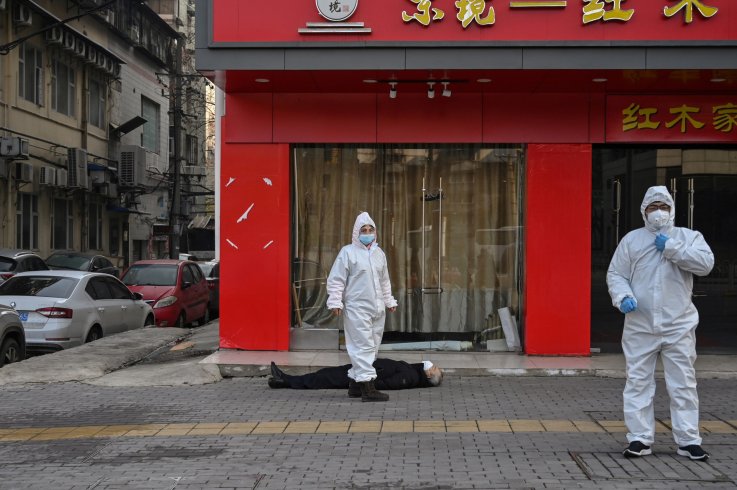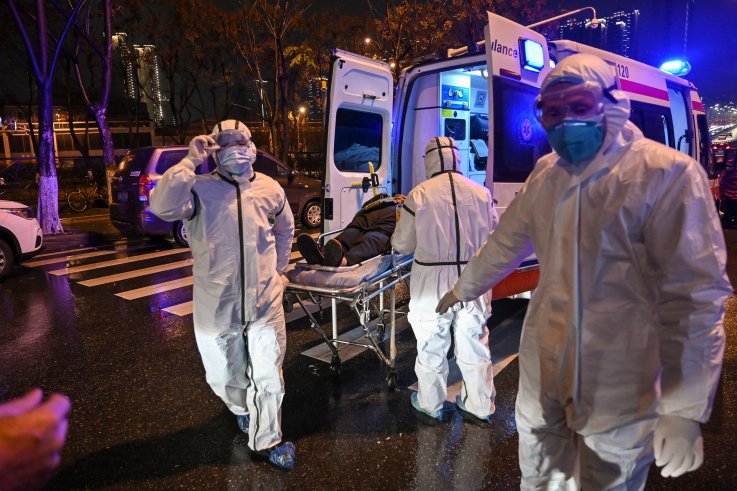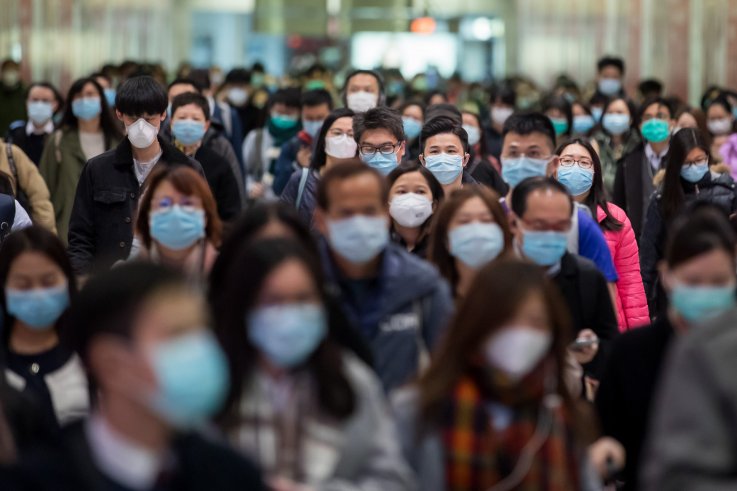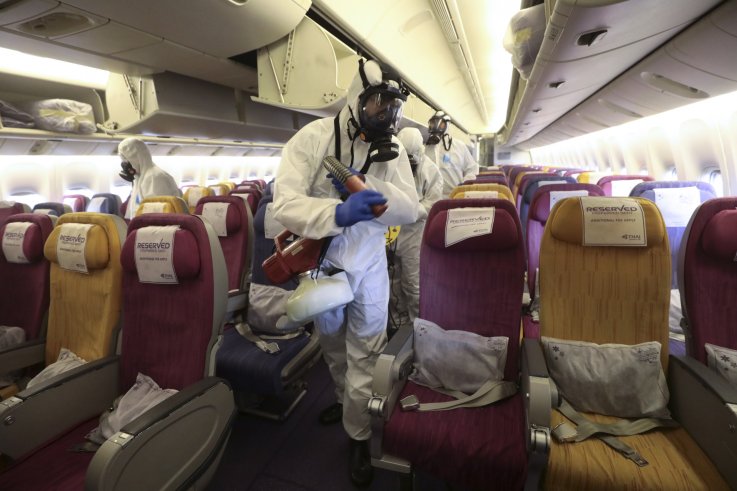BY MARGARET HAMBURG AND MARK SMOLINSKI
 China awoke to this outbreak with greater attention as a nation, having been through the SARS outbreak. Officials were more transparent in sharing news and the genetic sequence of this novel strain. However, no drugs, vaccines or other medical interventions are yet available Below: Health workers check on an elderly man who collapsed in the street in Wunan.HECTOR RETAMAL/AFP/GETTY
China awoke to this outbreak with greater attention as a nation, having been through the SARS outbreak. Officials were more transparent in sharing news and the genetic sequence of this novel strain. However, no drugs, vaccines or other medical interventions are yet available Below: Health workers check on an elderly man who collapsed in the street in Wunan.HECTOR RETAMAL/AFP/GETTY
In 2011, a novel virus,MEV-1, emerged from China and quickly spread throughout the world, killing 2.5 million people in the U.S. and 26 million worldwide.
That outbreak wasn't real, of course—it was the plot of the film Contagion, providing a Hollywood-style glimpse into the panic that surrounds a global pandemic. At the moment, we're in the midst of a very real outbreak spreading throughout the world from China. The real outbreak and the fictional one are related in one important way: a virus made the "jump" into an unprepared world.
This new outbreak is both frightening and familiar. Looking back over many decades, recent viral outbreaks fit a pattern that is now well-recognized. It goes like this: a virus that lives in animals makes the jump to humans. Perhaps it happens in a live-animal market, such as the one in Wuhan, China, that authorities initially flagged as the source of the current outbreak, or perhaps it came from some other animal source. People start getting sick and passing the infection around. Nobody pays attention for days, weeks or even months if the majority of cases are mild and go unnoticed, or they are assumed to be related to other known diseases circulating in the region.
Sometimes the public is unaware of a potential new threat because authorities are keeping quiet to avoid causing panic or retribution if they are wrong about early details. Then, suddenly, an outbreak is detected, the alarm sounds, the public takes notice and the world is enveloped in a global crisis.
The current crisis is caused by a coronavirus—a class of pathogens that includes the common cold, which means it's a new version of an old foe. This particular virus, called 2019-nCoV, appears to spread from person to person fairly rapidly and is already having serious consequences for public health. While many of the confirmed cases are reportedly mild, this novel coronavirus is causing death and severe illness, especially for vulnerable groups like the elderly and those who are immunocompromised. And it is causing disruptions in travel, trade, economic activity and productivity. We need to take it very seriously, now. We don't yet know much about the virus and the contours of the outbreak it is causing—nor what it could become if it mutates, which is a natural feature of coronaviruses.
 China has responded to the outbreak with extreme measures. It has locked down entire cities, affecting tens of millions of people. Other countries have also put their own travel bans in place. Right: medical workers arrive at Wuhan Red Cross Hospital with a patient.COSTFOTO/BARCROFT MEDIA/GETTY
China has responded to the outbreak with extreme measures. It has locked down entire cities, affecting tens of millions of people. Other countries have also put their own travel bans in place. Right: medical workers arrive at Wuhan Red Cross Hospital with a patient.COSTFOTO/BARCROFT MEDIA/GETTY
Beyond the many worries about this particular outbreak is concern about the pattern of alarm and complacency that seems to characterize the world's response to such events. It's the same pattern we saw during the outbreak of SARS in 2002-3, H1N1 in 2009, MERS in 2012 and Ebola in 2014. Each time, the outbreak captured the attention of the public and the politicians. And each time, as fears subsided, complacency set in.
The longer we keep repeating this pattern, the more we'll have to put up with preventable disruptive outbreaks and the more people will get sick and die as a result. The longer this cycle continues, the greater the likelihood that nature will deal us a very bad hand—a pathogen that possesses a catastrophic combination of lethality and transmissibility.
On the last day of 2019, 27 cases of pneumonia from an unknown cause were reported from China to the World Health Organization. Most were said to have recently visited a large, live animal market in the city of Wuhan, which prompted its swift closure on January 1. Unfortunately, the live "goods" being sold in the market were reportedly not tested when the market was emptied and the animals were destroyed. By the time the virus was identified a week later, the case count had risen to 41 persons; the first death occurred two days later. As the month drew to a close, nearly 10,000 people were known to be infected and over 200 had died. Since the epicenter was in Wuhan, the vast majority of cases are in China, but sporadic cases have been confirmed in over twenty other countries. The World Health Organization declared it a "public health emergency of international concern" on January 30.
The tools of modern genomics make it possible to identify a new pathogen and decode its genetic sequence in a matter of days. At present, however, many unanswered questions remain about the nature of this novel virus. Where did it come from? How does it spread? What's the incubation period? How lethal is it? Can it spread from people without symptoms, and for how long? From a public health standpoint, we can't yet rapidly identify potential cases at all sites where people seek health care to manage them, monitor their close contacts, and limit the ongoing spread. And we don't have a vaccine that could prevent it going forward. As China and the global community mobilize to respond to this unfolding threat, we have lots of unanswered questions—and lots of needs—concerning this novel coronavirus.
This outbreak is a wake-up call. It reminds us of our vulnerability to emerging and unexpected infectious disease threats. Those threats include completely previously unknown organisms, such as HIV. They include new versions of old pathogens, like this coronavirus. They also include old pathogens that reemerge in new forms, such as those that develop resistance to antibiotics. They can be microbes that show up in new locations because of climate change, changing agricultural practices, highly mobile and displaced populations, urbanization and crowding. In the modern world, a microbe can travel very far, very fast. As a colleague of ours used to remark, a disease in a remote part of the world can be in your backyard tomorrow. All of that makes us increasingly vulnerable.
This novel coronavirus is a classic example of the emergence of new microbial threats and their spread. The vast majority of the new infectious diseases that have presented in recent decades have come from animals who host the microbes, and are said to be the "reservoirs." The spillover event, if you will, can sometimes involve a set of animal reservoirs and potentially a set of insect "vectors," like mosquitoes, ticks and fleas. But simply said, these so-called zoonotic pathogens live in animals or are carried by insects and then "jump" to humans. When they jump, they can cause new diseases that we haven't had to deal with before, like 2019-nCoV. Unfortunately, we're seeing the the emergence of several new zoonotic diseases each year—any of which may become the next pandemic.
 As 2019 drew to a close, a few dozen people, mostly in the Chinese city of Wuhan, caught a novel coronavirus and came down with pneumonia. In only a few weeks, the outbreak has spread to at least 20 other nations and is now an international health crisis.PAUL YEUNG/BLOOMBERG/GETTY
As 2019 drew to a close, a few dozen people, mostly in the Chinese city of Wuhan, caught a novel coronavirus and came down with pneumonia. In only a few weeks, the outbreak has spread to at least 20 other nations and is now an international health crisis.PAUL YEUNG/BLOOMBERG/GETTY
Even though these outbreaks are in a sense predictable, each one presents a unique puzzle to public health officials. The first serious coronavirus that we saw was SARS in 2002-3, which, like the current one, also originated in China and was thought to have spread to people from civet cats which were likely infected from bats. When SARS first struck, we also had many gaps in our understanding. Ultimately SARS resulted in over 8,000 cases in 29 countries, with a death toll of nearly 800. Toronto had a significant outbreak, and so did Hong Kong. But for reasons that are still mysterious, we didn't have a single known case in the United States. The MERS outbreak in 2012, which began in Saudi Arabia and spread from camels (also with the help of bats), has surpassed the death toll from SARS and has been detected in 27 countries.
Since MERS, public health experts have wondered when and where the next coronavirus was going to emerge. And now we have it: 2019-nCoV.
Right now, people seem to take comfort from comparing the new coronavirus with the flu. Seasonly influenza is another disease that goes from animals to humans. Influenza typically kills 1/10th of one percent of the people who are infected, higher in those with increased risk. Yet we still have tens of thousands of people who die every year from flu because it's so pervasive: the death rate is low, but since so many people catch it, the resulting death toll is high. Something like SARS or MERS might kill, say, 2 or 3 or even 10 percent of those who are infected, but, lucky for us, those viruses were not as transmissible as the flu. If they were, the results could have been devastating. The jury is still out on this new coronavirus.
We don't yet know how easily 2019-nCoV can transmit from one person to another. We are not even fully certain of the modes of transmission. If this new virus mutates into something that spreads more easily around the world or is more virulent, we will see even more devastation and disruption. Or it could mutate to become less pathogenic and less infectious. It could "burn-out" as we have seen with SARS. We just don't know. Having so many unknowns makes everybody nervous, as it should. Already we see the enormous toll taken by this evolving outbreak—on human life and health, but also on travel, trade, economies and our sense of trust and confidence in government and other institutions. The threat of a true pandemic is an existential risk.
Signs of Progress
We are no doubt inching towards progress. China awoke to this outbreak with greater attention as a nation, having been through this before with SARS. Chinese officials were more transparent in sharing news of 2019-CoV earlier in the outbreak than was the situation with SARS. Progress is also evident in how Chinese scientists openly shared the genetic sequence of this novel strain. This has enabled new insights into the nature of this emerging organism and critical information to support efforts to rapidly develop diagnostics and medical countermeasures. As a result, several rapid diagnostics are already available to help with testing and screening.
But right now there are no drugs, vaccines or other medical interventions available to treat 2019-CoV infections (apart from alleviating symptoms). Research efforts are being initiated to try to develop and test experimental therapies, drawing on our knowledge of SARS and MERS. Vaccine development efforts are also underway, including the recent announcement by the Coalition for Epidemic Preparedness Innovations (CEPI), an innovative partnership between public, private, philanthropic, and civil organizations, launched at Davos following Ebola, to develop vaccines to prevent future epidemics.
Chinese authorities have taken extreme measures to control the outbreak, including travel bans, restrictions on large public gatherings, school and work closures. There have also been "lock-downs" or quarantine of entire cities, involving tens of millions of people. The consequences of potential panic, social unrest and disruption of much needed supplies when a city is closed off will have to be evaluated in relation to the potential attempt to curb the extent of the spread.
China is not alone in its aggressive measures. Screening of travelers and outright travel bans are already in place in other countries, and airlines are restricting routes.The United States recently announced it will forbid entry to persons who have traveled recently in China if they are not U.S. nationals or immediate family members of U.S. citizens. Such drastic measures must be undertaken with caution. Under conditions of uncertainty and fear, the policies and procedures are not always based on the best possible science—yet are opportunities to better understand risk and explore innovations if we take the time to be thoughtful and systematic.
As cases spread to other countries, we are seeing mobilization of response on a national and International level. However, things aren't nearly where they need to be. For one thing, many countries that are potentially vulnerable don't have adequate public health systems. Even those that are more sophisticated aren't as strong as they should be in terms of early detection and rapid response capabilities.
One of the reasons a global public health emergency has been declared is to raise awareness and help less prepared countries deal with this spreading outbreak. If this novel coronavirus were to spread to a country lacking the infrastructure to detect cases and track contacts, as is being done in more heavily resourced countries, it would endanger not only that nation but the health security of us all. This is especially bad news when the most recent analysis of the Global Health Security Index revealed that no country anywhere is fully prepared for a pandemic.
 Crew members disinfect a Thai Airways airplane.PATIPAT JANTHONG/ECHOES WIRE/BARCROFT MEDIA/GETT
Crew members disinfect a Thai Airways airplane.PATIPAT JANTHONG/ECHOES WIRE/BARCROFT MEDIA/GETT
The Promise of Preparedness
When a crisis strikes, we wake up—briefly. Then we hit the snooze button. For example, following the SARS outbreak, the WHO updated a system of international health regulations to ensure a minimum set of capabilities for countries around the world for rapid detection, response and preparedness for infectious disease threats that may be of global concern. Many countries made commitments, including having an identified person responsible for coordinating these efforts in each country. When the Ebola outbreak occurred, however, most countries' public health systems were still woefully unprepared.
Now that we're in the midst of a crisis—while we're wide awake—it's a good time to reconsider how we think about our response to disease outbreaks. The first thing we need to do is re-frame the issue not as an isolated emergency response but as an ongoing effort to prevent outbreaks from happening in the first place.
When it comes to an outbreak of an infectious disease, speed is of the essence. Speed of detection, of reporting and of response are all crucial so that the global community can be as prepared as possible to address the threat, and limit or prevent spread. Any delay in detecting a novel threat translates into greater spread, illness, social and work disruption, and additional lives lost.
Success will require a continuum of leadership, capabilities, collaboration and accountability—from local to global. Transparency begins with the reporting of unusual illness or clusters of disease, generally first by health care workers, village health volunteers, or an informed public. Once an unusual cluster of illness or suspected outbreak is detected, the cause of the illness must be quickly determined to guide a rapid and effective response. Health authorities at the local, regional and national levels all have a responsibility to share information more broadly.
In under-resourced countries, early efforts should include an emphasis on risk communication, early detection, access to health care, isolation infrastructure and contact tracing. Much of what needs to be done involves applying age-old fundamentals of public health, while advances in science and technology enable us to bring new and more powerful tools to these efforts. This allows for scientists and technicians to develop diagnostics to track the outbreak and for drug and vaccine manufacturers to initiate more targeted efforts to develop medical countermeasures.
We also have the opportunity to apply more sophisticated approaches to the fundamental needs of disease detection and surveillance. Outbreaks where people show no symptoms of illness but are still capable of spreading the disease are the hardest to control. That makes it even more important to catch early cases when people first start reporting to healthcare centers. In some countries, farmers and workers in the live animal markets who have the highest contact with potential new pathogens are connected to innovative, community-led surveillance systems to report symptoms of illness or to report a sick or dead animal.
In the U.S., we have a system called Flu Near You where people report symptoms of flu every Monday to give us a better idea of how much illness is circulating in a community. Flu Near You is currently being adapted to add questions about coronaviruses to alert the population and get them to start reporting anything they see. Other innovations in self-reporting, social media, machine learning and artificial intelligence are providing opportunities to find outbreaks faster so that we can stop a threat anywhere from becoming a threat everywhere.
Ending pandemics is in our future. We are far from realizing the full power of collaborative forces necessary to prevent the global spread of a new virus. We have, however, made incredible progress in identifying critical factors for the emergence of new diseases and in helping build capacity to Identify and respond to outbreaks more rapidly in disease "hotspots." Unless we start socializing a greater understanding of where diseases are likely to pop up and why they're happening, we'll continue to have outbreaks, we'll continue to respond to crises. And we'll wonder why the public is surprised every time.
No comments:
Post a Comment